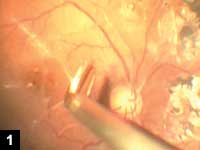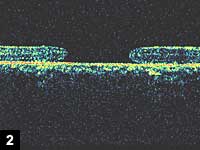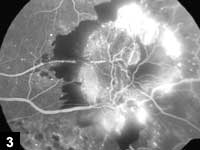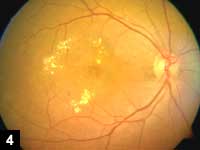Undesirable result possible after uneventful cataract surgery
Surgeons must learn to diagnose and treat hidden problems when surgery does not turn out as planned.

At the end of an uneventful cataract extraction, each of us heaves a sigh of relief because the patient is ultimately expected to regain a visual acuity of 20/20. But what happens if despite an uncomplicated surgery, things do not work out the way you want it to? One may then end up with an undesirable scenario. It is therefore important for every anterior segment surgeon to be able to analyze and understand why his patient is not seeing well and what his options are.
CME and endophthalmitis
 Amar Agarwal |
A common scenario that surgeons face after uncomplicated phaco is postoperative cystoid macular edema. Postoperative acute endophthalmitis is a devastating complication after cataract surgery and can be seen as increased pain, redness, lid edema, anterior chamber reaction, corneal haze, vitreous haze, frank exudates in the vitreous or absent red reflex. This condition needs to be treated as an emergency with maximum medical therapy and may sometimes require vitrectomy.
Other scenarios
There are other scenarios in which the cataract surgeon may come across previously undetected retinal pathologies in the postoperative period — pathologies that were not detected in the preoperative period due to media opacity or some other factor. This can include conditions such as epiretinal membranes or macular holes.
Epiretinal membranes may be seen as a change in the macular texture or as fine wrinkles or striae on the macular surface with straightening and traction on the blood vessels. Optical coherence tomography (OCT) shows a hyper-reflective membrane on the surface of the retina, and fundus fluorescein angiography (FFA) shows distortion and straightening of the normal vascular layout, varying degrees of leakage, late staining of the membrane and sometimes associated macular edema. Epiretinal membranes can be removed by first doing a vitrectomy to remove the posterior hyaloid and then peeling the epiretinal membrane (Figure 1).
A macular hole may also be seen in the elderly population. It is seen as a sharply punched-out area in the macula with yellowish deposits at the base. On FFA, a full-thickness macular hole presents as a window defect surrounded by sharp margins. The hyperfluorescence fades in the late phase of the angiogram. The various stages of a macular hole can be identified on OCT (Figure 2), and this helps greatly in decisions regarding the need for vitreoretinal surgery.
|
|
|
|
|
Images: Agarwal A |
Complications of AMD
Another common condition in the elderly population is age-related macular degeneration. Geographic atrophy is seen as a well-defined area of chorioretinal degeneration, which unmasks the larger choroidal vessels. OCT shows attenuation of the retinal pigment epithelium choriocapillaris complex with increased signal seen from the underlying choroid. FFA shows a hyperfluorescent window defect that fades with the background choroidal hyperfluorescence. Choroidal neovascular membranes, seen in wet AMD, can be subfoveal, juxtafoveal or extrafoveal. Choroidal neovascularization is well-demarcated when its boundary is well-defined for 360°, whereas poorly demarcated CNV has a boundary that is not well-defined for the entire 360°. The classic pattern of CNV refers to well-demarcated early choroidal hyperfluorescence that is associated with late leakage into the sensory subretinal space. Indocyanine green angiography (ICG) of CNV shows a “hot spot” that is a small, less than one disc diameter, well-delineated area of focal CNV that is bright on ICG and may be successfully treated with laser photocoagulation.
Treatment options for exudative AMD include thermal laser photocoagulation, verteporfin photodynamic therapy, transpupillary thermotherapy, feeder vessel laser photocoagulation and intravitreal anti-VEGF factors such as triamcinolone, pegaptanib, ranibizumab and bevacizumab. Surgeries such as macular translocation, submacular surgeries, and iris or retinal pigment epithelium transplantation have been tried with varying success.
Branch retinal vein occlusion typically involves one retinal quadrant, usually the superotemporal, whereas in central retinal vein occlusion, the hemorrhages involve all the quadrants of the retina. FFA determines the presence or absence of leakage, ischemia and neovascularization (Figure 3), the amount of reperfusion and the presence of optociliary shunt vessels. It can also be used to check for iris neovascularization. OCT is used to confirm the status and extent of involvement of the macula. Systemic workup and photocoagulation in case of extensive ischemia or neovascularization is done. Vitrectomy may be required for clearing vitreous hemorrhage or for a retinal vein sheathotomy or radial optic neurotomy.
Diabetic retinopathy is a common condition that can range from a few scattered microaneurysms (Figure 4) to vitreous hemorrhage with complicated traction retinal detachments. FFA is the best mode of investigation to classify and diagnose diabetic retinopathy into nonproliferative diabetic retinopathy, proliferative diabetic retinopathy and diabetic maculopathy. OCT helps in the diagnosis of clinically significant macular edema and to document the details of epiretinal membranes. B-scan plays a major role in cases in which the posterior segment view is obscured by vitreous hemorrhage.
Diagnosis of other conditions such as central retinal artery occlusions, choroiditis, central serous retinopathy, colobomas or macular dystrophies is also helped by FFA and OCT. Thus, we see that there are many vitreoretinal conditions that the anterior segment surgeon may come across in his practice, and it helps to be familiar with the clinical presentation, OCT, FFA and treatment modalities available for these conditions.
For More Information:
- Amar Agarwal, MS, FRCS, FRCOphth is director of Dr. Agarwal’s Group of Eye Hospitals. Prof. Agarwal is the author of several books published by SLACK, Incorporated, publisher of Ocular Surgery News, including Phaco Nightmares: Conquering Cataract Catastrophes, Bimanual Phaco: Mastering the Phakonit/MICS Technique, Dry Eye: A Practical Guide to Ocular Surface Disorders and Stem Cell Surgery, and Presbyopia: A Surgical Textbook. He can be reached at 19 Cathedral Road, Chennai 600 086, India; fax: 91-44-28115871; e-mail: dragarwal@vsnl.com; Web site: www.dragarwal.com.
References:
- Agarwal A, Agarwal A, Agarwal S. Phacoemulsification. 3rd ed. Thorofare, NJ: SLACK Incorporated; 2004.
- Agarwal A. Phaco Nightmares: Conquering Cataract Catastrophes. Thorofare, NJ; SLACK Incorporated; in press.
- Agarwal A. Handbook of Ophthalmology. Thorofare, NJ: SLACK Incorporated; 2005.
- Agarwal A. Fundus fluorescein and indocyanine green angiography: A textbook and atlas. Thorofare, NJ; SLACK Incorporated; in press.




